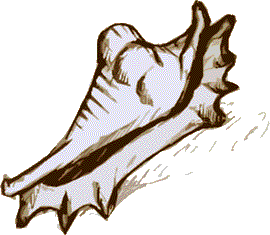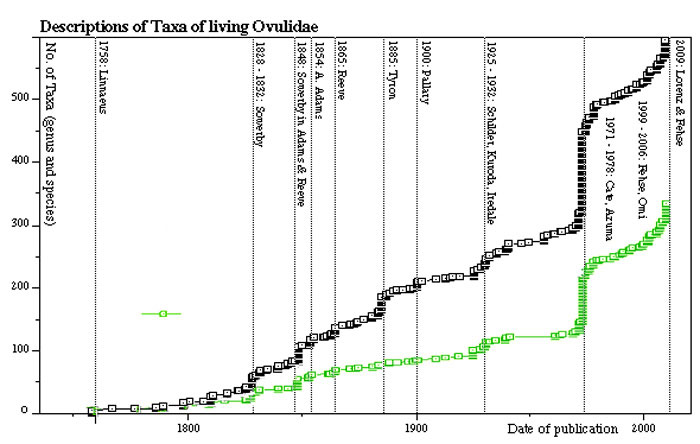
www.OVULIDAE.com
The state of research of living Ovulidae, Pediculariidae and Eocypraeidae
by Felix Lorenz
by Felix Lorenz
The history of taxonomic work of the allied cowries reveals that until the times of colourful publications such as Sowerby's Thesaurus, very few species of Ovulidae were named. At the same time, one third of all cowry species had been named at least once. One reason is certainly the lack of material, as most Ovulids are subtidal, but on the other hand, many deep-water species of other families had then been known, e.g. from museum's expeditions. The invention of Scuba-diving on the other hand seems to have had less impact on the account of new species than in other families. Few of the taxa named by Cate were obtained by divers but usually came from the fishing industry and beach-collecting.
Presently, there are 600 taxa of living Ovulidae (548), Pediculariidae (48) and Eocypraeidae (4). This account includes all higher level taxa such as subfamily and genus. There are 254 described species currently regarded as valid, 235 of which are ovulids in strict sense, 20 Pediculariidae and 1 Eocypraeidae. Interestingly, few authors ever paid close attention to Ovulids and their allies. On counting the taxa (including synonyms and higher level-), only eight authors have been involved in naming more than ten taxa. These are Cate (183), Sowerby (50), Azuma (47), Fehse (30), Schilder (28), Tryon (19 - none of which is considered valid nowadays), Iredale (13) and Reeve (11). In the book of 2009 by Lorenz & Fehse, 23 new taxa are introduced and two more were described by Lorenz earlier the same year.
After Sowerby's Thesaurus, the amount of taxa got multiplied by four within one century. Again, few authors described new taxa, most active taxonomists of these early days were busy with other families. This general trend continued into the 1970ies, when few authors described species and few general shell-books depicted more than a dozen species. In 1973 Cate published a monumental work revising the Ovulidae (excluding Pediculariidae) in a supplement of The Veliger. He illustrated all available holotypes and described 129 new taxa. Ever since this work, several descriptions of new species (and synonyms) followed, and for the first time, a chapter depicting shells and animals in colour and with comprehension was published by Liltved (1989). On the other hand, not until Fehse gave a comprehensive review in 2001 had the group been touched in terms of revising its systematics. This shows how solid the fundament was that Cate had provided, but also, that few taxonomists had an interest in the Ovulidae and related groups.
The diagram reveals that the account of taxa rose slowly for two hundred years and then got doubled by the work of Cate 1973. Many of the taxa introduced since are higher-level (genus and subfamily-level) while half of the taxa Cate introduced are nowadays considered synonyms. Both graphs show the same trend, except for the missing step of valid taxa out of those 19 introduced by Tryon. The distinct step of Cate's 1973 work is obvious, as well as the more steady rise of new taxa introduced since, until today.
black line: including synonyms
green line: taxa regarded valid

Today, we still have a fairly fragmentary overview to ovulid-occurrences. Diversity seems greatest in the western Pacific, namely the Philippines and Japan, but this impression is deceiving because those are the areas most intensely investigated. On the few occasions in which sampling has been conducted by experienced collectors in other places, a surprising amount of species was found. It turns out that most species considered endemic to Japan, after being discovered in the Philippines, have distributions stretching across the Indo Pacific, from western Polynesia to South Africa. The least known areas are those with the most intense activity of Scuba-divers, namely the Red Sea and the Maldives. There is a lot of evidence that ovulids thrive in these areas, but apart from photographs of living animals there is very little material available to taxonomists. Other areas which urgently need to be investigated better are the entire East African coast, the Persian Gulf, the central Indian Ocean, the coasts of India, Sri Lanka, Burma, Myanmar and Thailand, as well as the Indian Ocean coasts of Indonesia. There are areas in the Caribbean which are very poorly investigated, and finally, the entire western coast of Africa is less well known than the deep water seamounts in the central Atlantic.
Ovulid-distribution and state of research:
| Colour: areas where ovulids and related groups have been found |
|
| Areas almost unstudied |
|
| Poorly studied |
|
| Rather well studied |
|
| Best studied |
|
